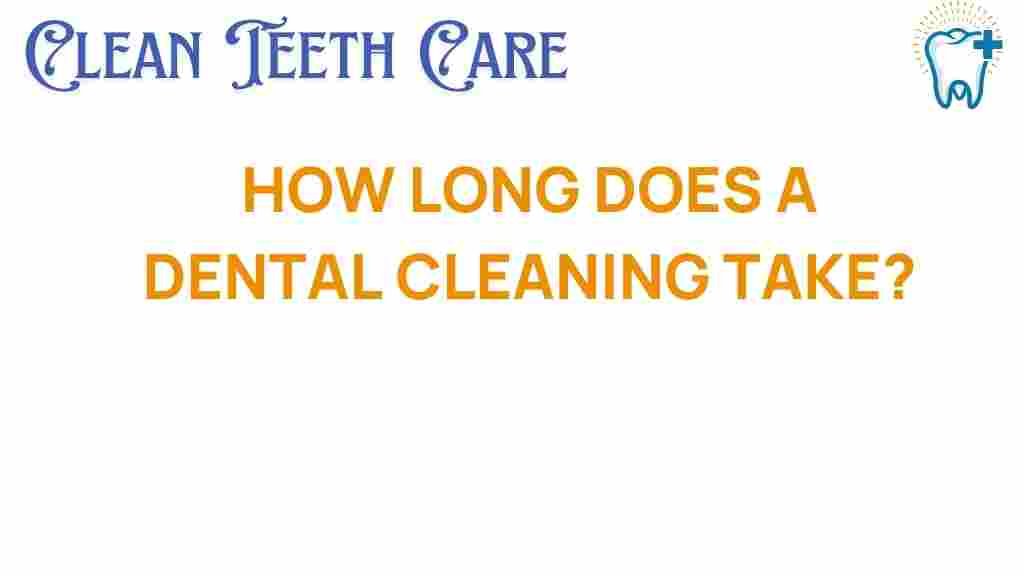Unveiling the Time: How Long Does a Dental Cleaning Really Take?
When it comes to maintaining oral hygiene, one of the most important practices is regular dental cleaning. Many people often wonder, “How long does a dental cleaning really take?” Understanding the time required for a teeth cleaning can help you better plan your dentist appointment and manage your schedule. In this article, we will delve into the details of dental cleanings, exploring what to expect during the process, the factors that influence the duration, and the overall impact on your dental health.
The Importance of Dental Cleaning
Regular dental cleaning is vital for maintaining good oral health. It helps to:
- Remove plaque and tartar buildup, which can lead to cavities and gum disease.
- Prevent bad breath by keeping your mouth clean and fresh.
- Identify potential dental issues early, allowing for prompt treatment.
- Enhance the effectiveness of your daily oral care routine.
By understanding the time involved in a dental cleaning, you can prioritize your dental care and ensure you are taking the necessary steps to protect your teeth and gums.
Factors Influencing the Time Required for a Dental Cleaning
Several factors can influence how long your dental cleaning will take:
1. Type of Cleaning
There are generally two types of dental cleanings:
- Routine Cleaning: This is a standard cleaning for patients with good oral hygiene. It typically takes about 30 to 60 minutes.
- Deep Cleaning: Recommended for patients with gum disease, this cleaning requires more time, often ranging from 1 to 2 hours, as it involves scaling and planing below the gum line.
2. Patient’s Oral Health Status
If you have a history of dental issues, such as gum disease or cavities, more time may be needed to address these problems during your appointment. Your dentist may need to focus on specific areas that require extra attention, extending the appointment duration.
3. Dentist’s Approach and Equipment Used
Modern dental practices often utilize advanced technology, such as ultrasonic scalers, which can speed up the cleaning process. However, the dentist’s method and thoroughness can also affect the duration of the cleaning.
4. Patient Comfort and Communication
Some patients may require additional time if they experience anxiety or discomfort during the cleaning. Effective communication with your dentist about your comfort levels can lead to a more efficient process.
What to Expect During a Dental Cleaning Appointment
Knowing what happens during a dental cleaning can help alleviate anxiety and prepare you for the experience. Here’s a step-by-step breakdown:
Step 1: Initial Examination
Your appointment will start with a brief examination of your teeth and gums. The dentist will check for any signs of decay and evaluate your oral health status. This step usually takes about 5 to 10 minutes.
Step 2: X-rays (if necessary)
If it’s been a while since your last visit or if your dentist suspects any underlying issues, they may take X-rays. This can add an additional 10 to 15 minutes to your appointment.
Step 3: The Cleaning Process
The actual dental cleaning process involves several key steps:
- Scaling: The dentist or dental hygienist uses specialized tools to remove plaque and tartar from your teeth. This process can take 20 to 30 minutes.
- Polishing: After scaling, your teeth will be polished using a gritty toothpaste. This helps remove surface stains, taking about 10 minutes.
- Flossing: The dentist will floss your teeth to ensure that no debris is left behind, which usually takes about 5 minutes.
- Fluoride Treatment: Finally, a fluoride treatment may be applied to strengthen your teeth and prevent cavities, taking an additional 5 minutes.
Step 4: Post-Cleaning Consultation
After your cleaning, the dentist will discuss your dental health and provide tips for maintaining good oral hygiene. This consultation typically lasts around 10 to 15 minutes.
Common Concerns About Dental Cleaning Duration
Many patients have concerns regarding the time required for a dental cleaning. Here are some troubleshooting tips to address these concerns:
1. Anxiety About Time
If you’re anxious about how long the cleaning will take, consider scheduling your appointment during a less busy time at the dental office. This can reduce wait times and overall stress.
2. Overdue Cleanings
Patients who haven’t had a cleaning in a while may worry about the time it will take. While it’s true that longer cleanings may be required, the dentist will work efficiently to ensure your comfort and care.
3. Busy Schedule
If you’re pressed for time, communicate this to your dentist. They can often tailor the cleaning to fit your schedule while still addressing your oral health needs.
Conclusion: Prioritizing Your Dental Care
Understanding how long a dental cleaning takes can help you better plan your dentist appointment and prioritize your dental care. Regular cleanings are essential for maintaining good oral hygiene, preventing dental issues, and ensuring a positive patient experience.
In general, expect your routine cleaning to take between 30 minutes to an hour, while deep cleanings may require more time. Remember, investing time in your dental health today can save you from more extensive treatments in the future.
If you’re looking for more information on dental care and improving your oral health, check out this informative resource. Additionally, you can find tips on how to prepare for your next dentist visit at this helpful article.
Make dental cleanings a regular part of your health routine, and you’ll enjoy the benefits of a bright, healthy smile for years to come!
This article is in the category Hygiene and created by CleanTeethCare Team
